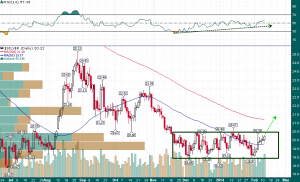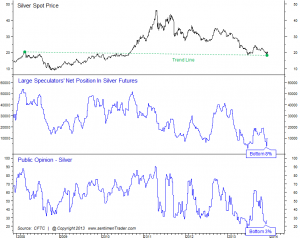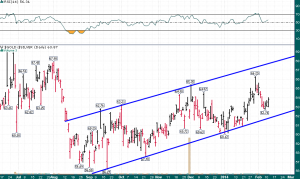Disclaimer:
Readers are advised that the material contained herein is solely for information purposes. Readers are encouraged to conduct their own research and due diligence, and/or obtain professional advice. Nothing contained herein constitutes a representation by the publisher, nor a solicitation for the purchase or sale of securities. The information contained herein is based on sources which the publisher believes to be reliable, but is not guaranteed to be accurate, and does not purport to be a complete statement or summary of the available data. Any opinions expressed are subject to change without notice. The owner, editor, writer and publisher and their associates are not responsible for errors or omissions. They may from time to time have a position in the securities of the companies mentioned herein, and may change their positions without notice. (Any significant positions will be disclosed explicitly. This article is not intended to meet your specific individual investment needs and it is not tailored to your personal financial situation. Nothing contained herein constitutes, is intended, or deemed to be — either implied or otherwise — investment advice. Thomas Humphreys, Pacific Website Company Inc., and other entities in which he has an interest, employees, officers, family, and associates may from time to time have positions in the securities or commodities covered in these publications or web site. We reserve the right to buy and sell such securities or commodities without notice to readers. While the information herein is believed to be accurate and reliable it is not guaranteed or implied to be so. The information herein may not be complete or correct; it is provided in good faith but without any legal responsibility or obligation to provide future updates. Neither Thomas Humphreys, nor anyone else, accepts any responsibility, or assumes any liability, whatsoever, for any direct, indirect or consequential loss arising from the use of the information in these publications or web site.
Forward-Looking Statements: This article may include certain "forward-looking information" within the meaning of Canadian securities legislation. Forward-looking statements include predictions, projections and forecasts and are often, but not always, identified by the use of words such as "seek", "anticipate", "believe", "plan", "estimate", "forecast", "expect", "potential", "project", "target", "schedule", budget" and "intend" and statements that an event or result "may", "will", "should", "could" or "might" occur or be achieved and other similar expressions and includes the negatives thereof. All statements other than statements of historical fact included in this release, including, without limitation, statements regarding the potential of the Company's properties are forward-looking statements that involve various risks and uncertainties. There can be no assurance that such statements will prove to be accurate and actual results and future events could differ materially from those anticipated in such statements. Forward-looking statements are based on a number of material factors and assumptions. Important factors that could cause actual results to differ materially from Company's expectations include actual exploration results, changes in project parameters as plans continue to be refined, future metal prices, availability of capital and financing on acceptable terms, general economic, market or business conditions, uninsured risks, regulatory changes, delays or inability to receive required approvals, and other exploration or other risks detailed herein and from time to time in the filings made by the Company with securities regulators. Although the Company has attempted to identify important factors that could cause actual actions, events or results to differ from those described in forward-looking statements, there may be other factors that cause such actions, events or results to differ materially from those anticipated. There can be no assurance that forward-looking statements will prove to be accurate and accordingly readers are cautioned not to place undue reliance on forward-looking statements which speak only as of the date of this article. The Company disclaims any intention or obligation, except to the extent required by law, to update or revise any forward-looking statements, whether as a result of new information, future events or otherwise.
Always do your own due diligence. We seek safe harbor.

























People who deal in “technical analysis” are almost never qualified as historians, “historical average in the 55-60 range” well that’s mere recent history, and is very distorted by COMEX and OTC opaque derivatives, with a few other exceptions, as in February 1931 when silver was clubbed down to 84.37 to 1 gold ounce by the British dumping hundreds of millions of ounces of Indian silver. Someday the geological ratio and the above ground ratio will converge and jointly kick these distorted ratios off the stage and silver will achieve 9:1 to gold or better. Even in January 1980 silver was about 16.7 to 1 to gold (close to the historic monetary ratio)—even with an industrial cartel exerting to club silver down. When the Hunt/Arab silver play was crushed, Andrew Brimmer was on the COMEX governing board and a director of Du Pont (Silver Users Association) at the same time! Conflict of interest is SOP on the shortside of silver. These silver/gold ratios are entirely made up and when Big Influence can no longer force maintenance of the skewed ratio, people holding gold will burst into tears because they could have held silver. A silver move to $22 shows the opinion piece to be a comedy. Kitco shows the gold/silver gain today was 16:1 and $22 still looks like a deep hole. The Nixon Cost of Living Council in 1972 imposed a Federal price cap of $1.61 on domestic silver. Current intervention is more camouflaged.
I loved the detail in this answer, and I thank you for it. But there is one comment I intuitively found hard to accept – “Someday the geological ratio and the above ground ratio will converge”. Why? Surely the price of anything which is set by a “market” reflects the supply:demand ratio for it. (And I accept that PM pricings are massively distorted by these market currently trading paper contracts in volumes far beyond the physical volumes which are really available). But in this context we know today where large quantities of silver and gold exist in the earth, and there is quite a clear cost curve for accessing these. So why wouldn’t that more accurately reflect the natural gold:silver ratio (or at least define one natural value for this ratio in a supply constrained market)? Just because there are certain quantities of silver or gold above or below ground does not by itself set prices or ratios. Wouldn’t it be the demand for these PMs and replacement costs that ultimately set prices and ratios?
I expected that—it’s clockwork! Natural ratios have been set at defiance for at least 200 years, since the close of the Napoleonic Wars, when Britain determined more than ever previously to make gold the universal money—as a transitory measure en route to going full fiat. The reason was to deprive silver countries of their wealth! Our national legislation through the various Coinage Acts has been excessively tampered with by British interests and their tag-alongs, the New York money mob, for generations. Legislation however in the end, cannot forever overturn natural law and natural ratios. The Coinage Act of 1873 disallowed making payments in silver in sums of more than $5! This of course caused millions to forfeit their lands to interests who as of 1902-1903, coalesced into the formation of “The Pilgrims Society,” a Crown sponsored group founded to “gradually absorb the wealth of the world” (Review of Reviews May 1902 pp556-558). Interests who owned large amounts of gold saw the purchasing power of their holdings bound forward by an extent corresponding to the magnitude of the loss of purchasing power on the part of the victims who held silver. The New York banks boycotted the Morgan dollars in 1878 and had long since bought control of editorial policy. In the 1870s, Standard Oil Company alone was supplying editorials to over 300 newspapers. False facts are so jacked up by the media, even well intending sources absorb them as valid. Even as of 1930, the British Empire controlled 71.4% of the world’s gold output (Mining Congress Journal, September issue, page 681). It was no geological ratio that caused some 640 million silver ounces to be dumped onto the world market out of British India starting in 1927 (source—an ambassador to Germany, October 9, 1931, page 16, New York Times) naturally this crushed silver down to 24.5 cents the ounce. Clearly the bias has been very deliberate in intent to act against silver legislatively and this has created the distorted picture you are inclined to take as reality due to the torrential mass hypnosis inputs we’ve all had since childhood. The world could do without gold far more easily than silver no litany of reasons should be necessary here. Silver has disappeared from above ground and below ground sources. The only place on Earth silver occurs at depth comparable to gold is in Idaho where earthquake activity jumbled the strata. Silver is deposited “epithermally,” meaning relatively near surface. The Comstock lode, Cerro Rico in Bolivia and other major sources are long since depleted—Cannington cannot keep pace; Pascua Llama can’t be developed, Pitarilla is years away.. Demand will dictate price of silver/gold and this is why the natural ratio will have to take over. Return of monetary demand will soar over industrial demand like a basketball player over an embryo. Legislation by governments can’t do anything about the periodic table of elements, depletion of epithermal silver and the ratio. People won’t turn to rhodium for backing mirrors. I hope to say without stepping on your toes, what you said about prices and ratios is mere “cant” you may well have absorbed from Silver Users Association influenced sources. Every magazine and TV network receiving ad patronage from Dow Chemical, Du Pont and the rest and their banks, will tow this hokey line. Ditto for university economics faculties on the take. It has long been stressed that “polymetallic miners don’t care what price they get for silver byproduct” this has been true due to influence peddling but no scam can continue world without end amen. I again stress, “people holding gold will burst into tears because they could have held silver.” Centuries of silver price suppression dating to 1572 when the English seized Spanish silver on the high seas, will be remedied and it will take less than 9 silver ounces to buy 1 gold ounce. I am not especially struck by claims that silver may someday exceed gold in value as it did in ancient Egypt, until the Phoenicians started bringing in more silver to Egypt in trade. For the largest concentrated source of documentation on silver in existence see the entirely free access http://www.nosilvernationalization.org/ and the companion site linked. If you want to go into the nuts and bolts of cost geology, see my pal Steve St. Angelo at http://www.srsroccoreport.com